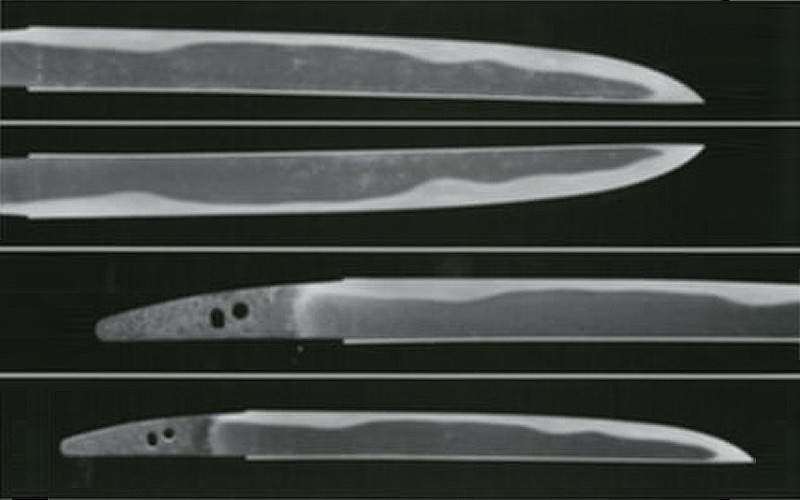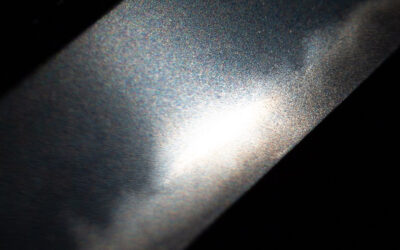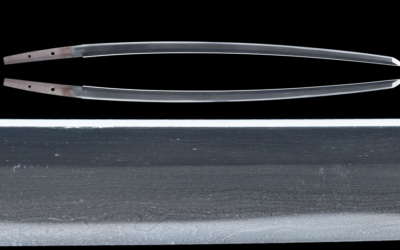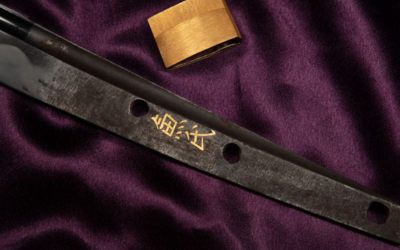
Project Info
Project Description
Tokubetsu-Jūyō Tōken at the 27th Tokubetsu-Jūyō Shinsa from April 20, 2022
Tantō, mumei: Den Masamune (伝正宗) Kinoshita Ayako (⽊下綾⼦)
Measurements Nagasa 26.9 cm, Sori uchizori, Motohaba 2.45 cm, Nakago-nagasa 9.9 cm, only very little nakago-sori
Description Keijō: hira-zukuri, mitsu-mune, normal mihaba, thin kasane, uchizori
Kitae: overall densely forged itame that is mixed with mokume and that features plenty of ji-nie and many larger-structured chikei
Hamon: nie-laden notare with a bright and clear and relatively wide nioiguchi that is mixed with gunome, thick yubashiri along the habuchi, and many kinsuji and sunagashi, which partially extend into the ji where they connect with the chikei
Bōshi: notare-komi with hakikake and a kaeri that tends to ko-maru
Nakago: ubu, kurijiri, the yasurime are indiscernible, two mekugi-ana, mumei Artisan Masamune from Sagami province
Era: End of Kamakura period
Explanation
Shintōgo Kunimitsu’s (新藤五国光) three students Yukimitsu (⾏光), Norishige (則重), and Masamune (正宗) further increased the approach of the Sōshū tradition – i.e., an emphasis on chikei, kinsuji, and nie – that had been initiated by their master, and perfected this style of sword making. It was Masamune in particularly, who skillfully combined steels with different carbon content and who demonstrated an utmost exquisiteness of nie, contributing so greatly to the elevation of the Japanese sword to being regarded as a work of art.
This tantō displays an overall densely forged itamethat is mixed with mokume and that features plenty of ji-nie and many large-structured chikei. The hamon is a nie-laden notare with a bright and clear and relatively wide nioiguchi that is mixed with gunome, thick yubashiri along the habuchi, and many kinsuji and sunagashi, which partially extend into the ji where they connect with the chikei.
The abundance of large-structured chikei and the thick yubashiri along the habuchi bear semblance to the matsukawa-hada of Etchū Norishige, and with the standard tantō-sugata with uchizori, we do see similarities in style with Norishige, but upon closer inspection it can be confirmed that the steel is not as blackish and subdued as to be expected from this smith. In addition, the hamon features more beautifully sparkling nie and is a hint brighter and clearer than seen with Norishige. With this considerations of quality ranking and the fact that the hamon in notare-chō would be more calm in case of Norishige, plus the noticeably tapering tang that does not end with a bulbous kurijiri as seen with Norishige, it is more appropriate to attribute this blade to Masamune. With the hardening in a notare with noticeable undulations and many beautifully sparkling ha-nie, and the frequent chikei and kinsuji along the jiba, we have here a masterwork by Masamune, which is of an excellent deki.
正宗 光徳⼑絵図巻所載 刃⻑⼋⼨⼋分半 薫⼭誌「花押」
Masamune Kōtoku Katana Ezu ken shosai Hachō hassun hachibu han Kunzan shirusu + kaō Masamune
Published in the Kōtoku Katana Ezu
Blade length ~ 26.9 cm Written by [Honma] Kunzan + monogram
熊本藩主細川家家⽼⽶⽥家ニ襲蔵サレシ正宗也地刃ニ眩ク輝ク沸ガ厚ク付キ地景・湯⾛・⾦ 筋・稲妻・砂流等働キ⾒事⽽沸ノ変化ノ極限ノ態様ヲ⽰シ同時ニ格調具ハリテ同⼯ノ所傳ハ妥 當也 珍々重々 時在壬寅秊弥⽣後学探⼭識「花押」
Kumamoto hanshu Hosokwa-ke karō Komeda-ke ni shūzō-sareshi Masamune nari. Jiba ni mabushiku kagayaku nie ga atsuku tsuki chikei, yubashiri, kinsuji, inazuma, sunagashi nado hataraki migoto shikamo nie no henka no kyokugen no taiyō o shimeshi dōji ni kakuchō sonawarite do7kō no shoden wa datō nari – Chinchin-chōchō Jizai mizunoe-toradoshi yayoi kōgaku Tanzan shirusu + kaō
This Masamune was a heirloom of the Komeda family, Karō elders in the service of the Hosokawa, who were the Daimyō of Kumamoto. Its jiba is brimful with brilliantly sparkling nie, and its gorgeous nie-based hataraki, e.g., chikei, yubashiri, kinsuji, inazuma, and sunagashi, create an unlimited abundance of variation, yet remaining dignity and elegance. Accordingly, an attribution to Masamune is appropriate. Very rare, very precious.
Addendum written by Tanzan [Tanobe Michihiro] in March of the year of the tiger of this era (2022) + monogram.




